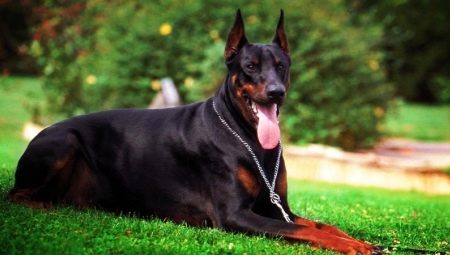Dobermans are large, short-haired service dogs. The author of the book “Dog Intelligence” S. Koren defined this breed in the group of the most capable dogs for training. Dobermans with proper education have a good flexible disposition. At the same time, in a critical situation, they can stand up for themselves and for their master.
Black color for the Doberman is natural, as it was in the breed initially.
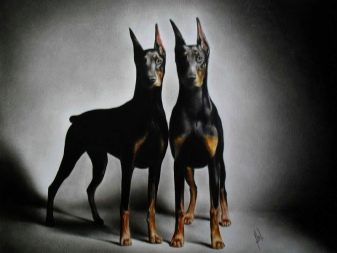

Origin history
At the end of the 19th century in Germany, Karl F. Dobermann was bred a breed of large guard dogs, which were named in honor of the creator Dobermanns. In 1894, after the death of the breeder, the word “pinscher” was added to the name “Doberman”. In 1949, during the editing of the standard, it was removed, returning the breed to its original name. Karl Friedrich Dobermann did not record breeding, so no one knows about the true origin of the dogs. It is believed that breeds such as Pinchers, Dogs and Rottweilers could be involved in creating the population.
Initially, individuals of this breed were more stocky, without much grace, with an aggressive character. Later, the breeder Otto Geller, breeding Dobermans, removed from the litter puppies with a ferocious disposition, thereby softening the character of the breed. Today they are obedient flexible dogs that can be easily brought up, but have not lost their security and detective qualities. The first show of representatives of Dobermans took place in 1897 in Germany. Literally from that day, the breed gained popularity, not lost until our time. The IFF recognized the population in 1960.

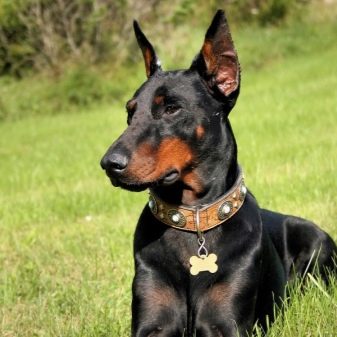
Description
Another breed standard was adopted at the end of 2015. According to him, animals should look in a certain way.
- If you look at the pet from above, the head has the shape of a wedge ending in a blunt nose.
- On the flattened forehead there is a small but clearly marked transition to the muzzle.
- The jaw is long with a scissor bite, with white teeth.
- Eyes of standard size. For a black Doberman, a deep dark brown color of the iris is permissible.
- Large erect ears with sharp ends are located on the highest part of the head, with the base adjacent to the cheeks.
- The neck is strong, muscular, of medium length.
- Raised elongated withers high.
- Strong back with elastic lumbar.
- The slightly oval chest has a standard width.
- A tucked up belly forms a beautiful, smooth line.
- The legs are thin, muscular, long.
- The tail is often docked. If kept, it looks like a small arc going up.
- Short shiny coat adheres to the skin. Vices are considered to be soft curly wool with peeling undercoat.
- The dog has a beautiful graceful silhouette, but at the same time a strong bony skeleton and well-developed muscles. The combination of elegance and power is characteristic of this particular breed.
The dog moves easily and resiliently, creates little noise while running. The step is natural, sweeping, the run is bewitchingly beautiful and impetuous.


Character
The days of the first ferocious Dobermans are long gone, the breeders tried by means of selective selection to get peace-loving friendly dogs. Moderate viciousness is brought up specially only as necessary if the dog has to perform security functions. Dobermans are considered smarter than European shepherds. They are easy to train.. If you pay a lot of attention to the dog, seriously engage in training, he will acquire the qualities necessary for the owner. The animal can be raised moderately aggressive to protect the territory. At the same time, the dog will not rush at all in a row: she understands the “friend or foe” ratio. He will not pester the guests of the owner with his diligent security actions, but he will not let the thief out of the yard.
Families that do not need a guard bring up a good-natured, outgoing friend who loves all family members. For young children, he can become a caring nanny. In the police service, the dog is well trained in detective work, as it has a keen sense of smell. With proper training, immaculately searches for any item, as well as people and animals. Whatever responsibilities are assigned to the Doberman, he will always be a loving and faithful pet for his master.
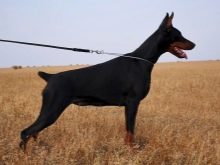
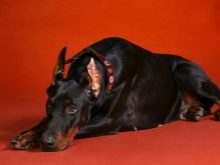

Black color
Black without tan marks was inherent in the first Dobermans. Today it is included in the breed standard and is rather highly valued, as it is obtained due to biological processes, which are more likely an exception than a rule. Genetically, a dog must have a tan coat, but a phenomenon such as melanism allows the animal to have a completely even black color. These are hereditary changes in which the genes responsible for the production of melanin are stronger.
Melanism has absolutely no effect on the health and physical development of the dog. It is a rare case when the ICF standards not only recognize genetic failure, but also award prizes to these animals at exhibitions.
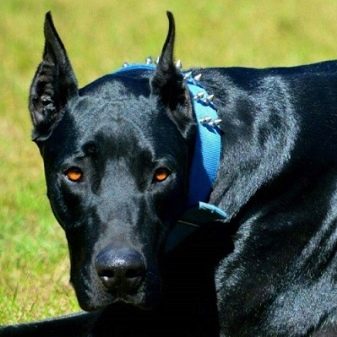

Dobermans have several types of black color.
- Anthracite - a beautiful, even color with a brilliant shimmer.
- Deep black. It has a slight red tint that can be seen in bright sunlight. The dog has a beautiful ebb on black wool due to the presence of a gene responsible for the red tint.
- Tan black - The natural color of the Doberman. But the tan should not be arbitrary, chaotic. The standard allows you to have it only on the face, withers, chest and limbs.
When puppies are born, black is detected immediately. More difficult with dogs of other colors. It is difficult to understand whether the baby will have isabella or blue color in the future: these shades are acquired over time.


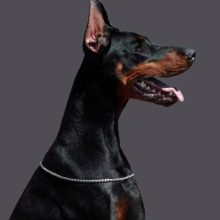
Care
Caring for a Doberman with black hair is the same as for other animals of this breed. The color of the fur is not affected by food, medicine or the use of shampoos. In order for the dog to be healthy and cheerful, certain measures are needed.
- Dobermans need an active lifestyle, they need walks, training, physical and mental stress. Without them, the pet will languish before our eyes.
- Most often, the tail is stopped by the dog, some owners also have ears.
- Dog claws are cut as they grow. With an active lifestyle, they grind on their own.
- You can bathe your pet once a month.
- Ears are cleaned several times a month, and eyes are washed if necessary.
- After a walk, check the paw pads: the dog could get hurt or rub calluses.
- In winter, a dog with short hair is uncomfortable. Walking should be reduced in duration or purchase clothing for the dog.
- For nutrition, you can use ready-made balanced premium feed. They are diversified by a small amount of natural food. You can completely transfer your pet to a natural diet: develop a menu that contains lean meat, boiled fish, cereals, vegetables, yogurt. Vitamins and minerals are added to the products as needed.
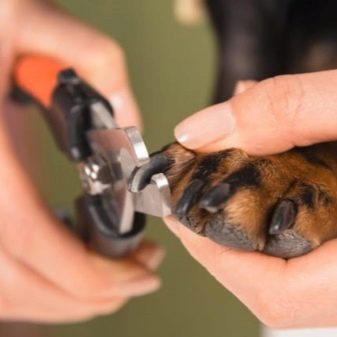

The choice
When choosing a puppy, you should pay attention to its appearance. It should be well-groomed, with clean mucous membranes, without swelling and odors. A swollen belly can indicate the presence of worms or a digestive problem. A healthy puppy is active and cheerful, he himself will run to sniff the person who approached him.
The patient will hide behind his mother or sit motionless. He can whine when picked up. Before making a choice, you should watch the puppies.
Too aggressive or, conversely, shy puppies are not inherent in this breed. Such behavioral reactions are considered a defect.


If the color of the coat is important, the color of the parents should be checked in the documents. Kids of a black key are usually guessed right away. A black puppy without tanning has only 2 shades: shiny and reddish. If others are present, it is better not to choose such a baby. When buying a Doberman, take into account the tasks that will be set for him, and price opportunities.
- Dogs costing 100–270 dollars may have slight deviations from the standard. Such animals do not participate in exhibitions. But this does not affect their character and mental abilities. Depending on their upbringing, they can become guards, guides, nannies, or simply good and faithful friends.
- Puppies costing 270-400 dollars can participate in exhibitions and are suitable for breeding.
- Dogs worth over $ 400 have an ideal pedigree, it is they who occupy prizes at all exhibitions.

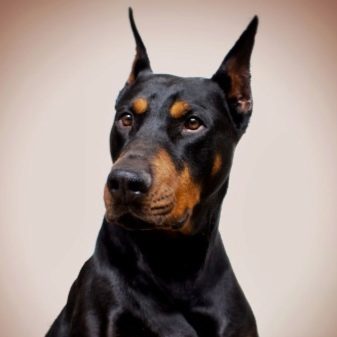
In the next video you will find additional information about this breed.
